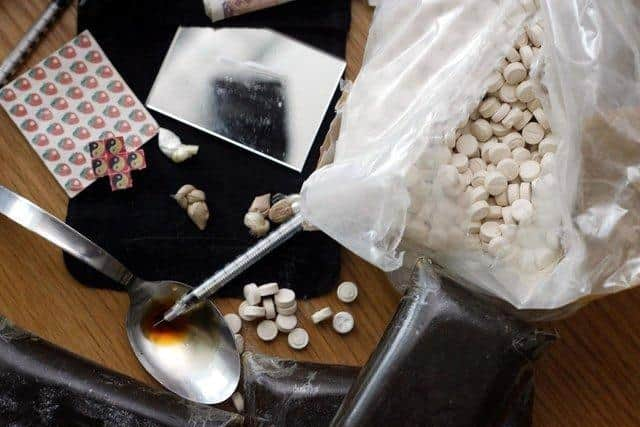Scotland drug deaths: How does Scotland compare to Europe? What are the prevailing drug trends?
The number of annual drug deaths in Scotland has fallen by more than 20 per cent – but Scotland still has the highest drug deaths rate in Europe.
The latest figures released by the National Records of Scotland (NRS) show 1,051 people died due to drug misuse last year, a decrease of 279 deaths (21 per cent) compared with 2021 and the lowest annual total since 2017.
Advertisement
Hide AdAdvertisement
Hide AdThis is, of course, very welcome news. But it is hard to celebrate the fact ‘only’ a thousand people lost their lives to drugs in Scotland last year. Instead, this step in the right direction should focus the minds of the Scottish Government to tackle the very Scottish problem of drug deaths.


The latest NRS figures show that in 2022, Scotland had a drug deaths rate of 248 deaths per million people. Comparatively, the latest estimates for England and Wales, from 2021, had 84.4 deaths per million, meaning Scotland’s drug death rate is almost three times higher.
To make matters worse, the number of annual drug deaths in Scotland is roughly twice what it was in 2013, when it stood at 527. The SNP has been in power since 2011.
"The data also reveals the complexity of drug use in Scotland where often more than one type of substance is taken,” Dr Lorna Nisbet, from the University of Dundee’s Leverhulme Research Centre for Forensic Science.
“The extent to which street benzodiazepines are being used in Scotland also contributes to this complex landscape and new benzodiazepines continue to emerge as drug legislation changes.
“This increasing variety within the Scottish drug market is cause for concern as the potency of these substances, and their effects when consumed in mixtures with other drugs, remain largely unknown. Considering these evolving trends and challenges, vigilance, research and joined up strategies will be essential to ensure Scotland’s drug related deaths continue to decline.”
According to PHS’s Rapid Action Drug Alerts and Response (RADAR) report in April, the most commonly detected individual drug is cocaine, followed by desmethyldiazepam – a benzodiazepine and also a metabolite of diazepam – followed by temazepam.
Between August last year and February, the ASSIST emergency department pilot made 1,022 detections of 52 different illicit drugs in samples from 190 patients.
Advertisement
Hide AdAdvertisement
Hide AdThe study collects anonymised data through the analysis of standard of care clinical data for patients attending Glasgow’s Queen Elizabeth University Hospital’s emergency department due to illicit drug toxicity.
More than one illicit substance was detected in 87 per cent of attendances. The most commonly detected individual drug was cocaine, appearing in one in ten drug detections.
The Scottish Police Authority Forensic Services laboratory has also confirmed the street purity of cocaine to be slightly higher than that of last year. In post-mortem testing, however, the most commonly detected drug type was opioids, such as heroin and morphine, at 37 per cent.
Annemarie Ward, chief executive of Faces & Voices Recovery UK, said there has been “a small investment” in recovery focused services.
“So organisations like Bluevale and Denistoun, community rehab, which have a focus on the whole community,” said Ms Ward.
“They've had some investment at Bluevale, but tiny amounts of investment in the grand scheme of things really.
“We have, in the last year, served over 120 people and we have helped them get access to services that they currently are having difficulty accessing, rehabilitation and residential services.”
Ms Ward added: “The Scottish Government says it has invested £20m in rehab, but we don’t see that bearing out, we don’t see it reaching people. If Audit Scotland can’t see that money, how can we?”
Advertisement
Hide AdAdvertisement
Hide AdMs Ward said that in 2022, there were only 23 publicly funded rehab beds in the Greater Glasgow & Clyde area, despite having 18,060 problem drug users and 132,955 problem alcohol users.
“That means only one person in every 6,565 will get the chance to go to rehab,” added Ms Ward.
Poly-drug use, where users ingest a concoction of drugs, is a prevailing feature of both hospitalisations and drug deaths in Scotland. More than 80 per cent of the tests conducted on patients in Glasgow between August and November detected more than one illicit drug or metabolite, even after legal substances – such as alcohol – and known prescribed medicines, including prescribed benzodiazepines and opioids, were removed from the testing.
Benzodiazepines appear to be the drug of choice for mixing with drugs such as heroin and cocaine, due to its therapeutic and anti-anxiety effects which can reduce the severity of withdrawals from opiates and cocaine. Of the tests which were positive for benzodiazepines, 48 per cent also tested positive for an opioid, while 100 per cent of cases positive for an opioid also tested positive for benzodiazepines.
Nearly 60 per cent of cases positive for benzodiazepines also tested positive for cocaine, while 73 per cent of cases positive for cocaine also tested positive for benzodiazepines. Illicit benzodiazepines are readily available online or on social media, and can cost as little as £1 a pill, according to drug users.
The Scottish Government’s drugs and alcohol policy minister, Elena Whitham, said: “We are taking action now to save and improve lives with an evidence-based approach – investing in and implementing policies that we know work to reduce harm and deaths from drugs and focusing on getting people into support and treatment.
“We are investing a total of £250m in our National Mission on drugs over the course of this Parliament and have already supported 300 grass-roots projects.
“We’ll continue to expand and improve access to residential rehabilitation and drive implementation of life-saving MAT Standards where we are making significant progress with more people getting treatment.”
Comments
Want to join the conversation? Please or to comment on this article.